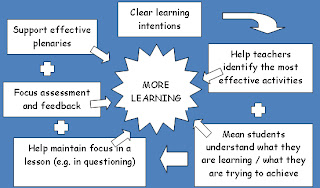Lesson
intentions should be shared with students in each lesson. Ideally they will be written on the board and
explained orally. It is essential that
lesson intentions are:
- Made visual
- In ‘pupil-friendly’ language
- Explained fully to the pupils
- Relevant to your starter
- Referred to
regularly throughout the lesson
- Reviewed in your plenary
Ideally,
if an observer asked students in your class, they would be able to explain what
they are trying to learn and why. Your questioning and explanations will be
focussed on the learning intentions of the lesson and the activities you set
will all help students to meet the intentions.
Intentions
vs Outcomes
In planning lessons, we
should consider the distinction between:
1.
Lesson intentions (What will the students be
learning?)
2.
Lesson outcomes/Success Criteria (What will
the students be doing? How will achievement be demonstrated by the students?)
N.B. When considering
the difference between intentions and outcomes, some teachers find it helpful
to think in terms of WALT (We Are
Learning To...) and WILF (What I am
Looking For...)
In planning, teachers should
decide what they intend the students to learn and then plan the activities that will support this learning. They should then review the learning outcomes to assess learning versus the
learning intentions.
Intentions
When
setting intentions, it is important that there is a clear distinction between
what students will do in the lesson
and what they will learn. Beginning a learning objective with the words
“To be able to…” is a simple and
effective way of ensuring your objective really is a learning objective and not
a description of the activity. If you
cannot use “To be able to…” the following stems may be helpful:
By
the end of the lesson students will:
·
know that
… (knowledge: factual information, e.g. names, places, symbols formulae,
events)
·
develop / be able to … (skills: using knowledge, applying techniques,
analysing information, etc.)
·
understand how / why … (understanding: concepts, reasons, effects,
principles, processes, etc.)
·
develop / be aware of … (attitudes and values: empathy, caring,
sensitivity towards social issues, feelings, moral issues, etc.)
Learning intentions may also
focus on how pupils learn (e.g. ‘to appreciate how peer assessment can help you
to improve your own work’).
When setting intentions
(and/or the learning outcomes), consider the level of challenge they contain
and try to avoid too many lessons being purely focussed on learning facts. Bloom’s
Taxonomy can be a useful tool (see Planning for Feedback folder for additional
resources) when thinking about how to introduce a greater level of challenge
into lessons. Ideally, we should be aiming to set intentions (and/or the
learning outcomes), towards the top of the scale as often as possible.
-
more complex thinking
-
more than one answer possible
-
less complex thinking
-
one correct answer
Learning Outcomes (or
Success Criteria)
Intentions will need
to be linked to outcomes (i.e. success criteria) so that students can
demonstrate they have met the intentions set out by the teacher. Building
appropriate success criteria into short-term planning is vital to ensure a
focus on learning as opposed to
activities. When planning, ask yourself;
·
What will my
students have learned and what will they be able to do at the end of the lesson
that they could not do before?
·
How will they demonstrate that they have met the
intentions?
·
How can I make
it clear to students what good quality
work will look like (and avoid simply focussing on task completion)?
Wherever possible, it is a
good ideas to include differentiated
learning outcomes. For example, using ‘must, could, ‘should’ or all, most, some’
For example:
Consider the learning
intention ‘To know about the structure of
the Earth’
Possible Differentiated
learning outcomes: -
-
You must draw and label a diagram to show the structure
of the earth, name the layers and sequence them into the correct order
-
You should add to your diagram at least one of the
characteristics of each of the layers so you can describe what it is like
-
You could choose 2 layers and compare and contrast their
characteristics using key words and connectives
Bloom’s can be useful here
in that it may guide you in deciding the nature of the outcome you are
expecting eg. all students expected to ‘describe’
their K and U, most expected to include an element of ‘explain’ and some may be asked to ‘justify´ their reasoning.
Throughout the lesson, success criteria should be shared with
students so that they always know what they need to do in order to demonstrate
success. Success criteria should:
·
be based on
the intentions
·
shape the
teaching and modelling and provide the students’
focus while they are working
·
provide the
key focus for all feedback and
assessment
Displaying success
criteria can provide a visual prompt
for students and teachers during the course of the lesson or sequence of
lessons.
It can also be very
useful to involve students in
setting the success criteria. For example, ask the students ‘what will you need
to do to demonstrate to me that you have met the intentions for this
task/lesson?’


No comments:
Post a Comment